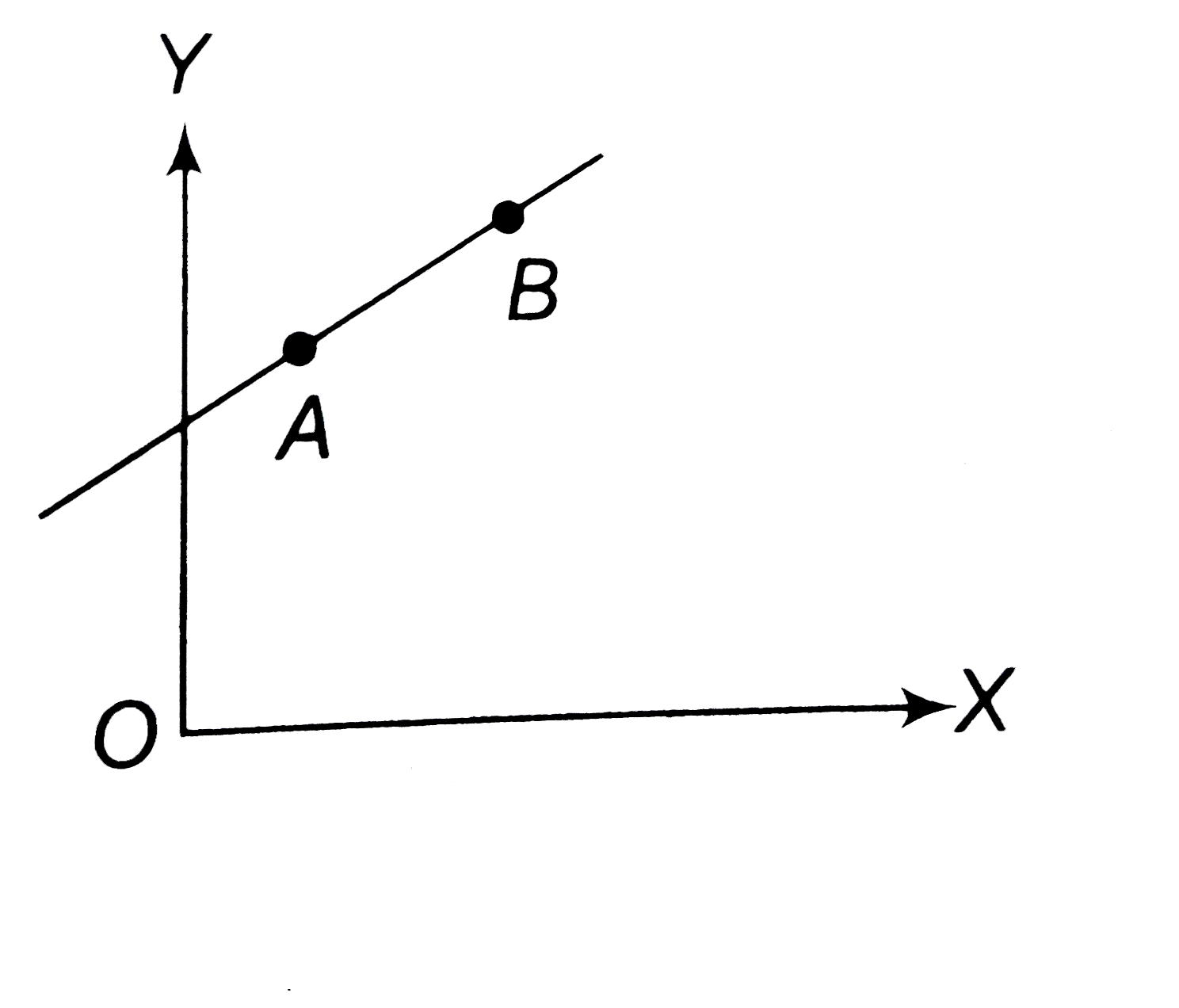A particle of mass m is travelling with a constant velocity v=v0ˆi along the line y=b,z=0. Let dA be the area swept out by the position vector from origin to the particle in time dt and L the magnitude of angular momentum of particle about origin at any time t. Then
L=constant
L≠constant
dAdt=2Lm
dAdt=L2m
The correct Answer is:A, D
To solve the problem step-by-step, we need to analyze the motion of the particle and calculate both the angular momentum L and the area swept out dA by the position vector from the origin to the particle.
Step 1: Understanding the Motion of the Particle
The particle of mass m is moving with a constant velocity →v=v0^i along the line defined by y=b and z=0. This means the particle is moving in the x-direction while maintaining a constant y-coordinate of b.
Step 2: Position Vector
The position vector →r of the particle at any time t can be expressed as:
→r=x^i+b^j+0^k=v0t^i+b^j
Step 3: Angular Momentum Calculation
The angular momentum →L of a particle about the origin is given by:
→L=→r×m→v
Where →v=v0^i. The magnitude of angular momentum L can be calculated as:
L=|→r×m→v|
Calculating the cross product:
→r=(v0t)^i+b^j
m→v=mv0^i
The cross product →r×m→v is:
→r×m→v=∣∣
∣
∣∣^i^j^kv0tb0mv000∣∣
∣
∣∣
Calculating the determinant:
=^i(b⋅0−0⋅0)−^j(v0t⋅0−0⋅mv0)+^k(v0t⋅0−b⋅mv0)
=−bmv0^k
Thus, the magnitude of angular momentum L is:
L=|bmv0|
Step 4: Area Swept Out Calculation
The area dA swept out by the position vector in a small time dt can be calculated using the formula for the area of a triangle:
dA=12×base×height
Here, the base is the distance traveled in the x-direction v0dt and the height is the constant distance b:
dA=12×v0dt×b=12bv0dt
Step 5: Relating Area Swept Out to Angular Momentum
From the previous results, we can relate dA to L:
dAdt=12bv0
And since we have L=bmv0, we can express dA in terms of L:
dAdt=L2m
Final Results
1. The magnitude of angular momentum L is given by:
L=bmv0
2. The area swept out in time dt is given by:
dA=12bv0dt
3. The relationship between the area swept out and angular momentum is:
dAdt=L2m
The particle of mass m is moving with a constant velocity →v=v0^i along the line defined by y=b and z=0. This means the particle is moving in the x-direction while maintaining a constant y-coordinate of b.
The position vector →r of the particle at any time t can be expressed as:
→r=x^i+b^j+0^k=v0t^i+b^j
The angular momentum →L of a particle about the origin is given by:
→L=→r×m→v
Where →v=v0^i. The magnitude of angular momentum L can be calculated as:
L=|→r×m→v|
Calculating the cross product:
→r=(v0t)^i+b^j
m→v=mv0^i
The cross product →r×m→v is:
→r×m→v=∣∣
∣
∣∣^i^j^kv0tb0mv000∣∣
∣
∣∣
Calculating the determinant:
=^i(b⋅0−0⋅0)−^j(v0t⋅0−0⋅mv0)+^k(v0t⋅0−b⋅mv0)
=−bmv0^k
Thus, the magnitude of angular momentum L is:
L=|bmv0|
The area dA swept out by the position vector in a small time dt can be calculated using the formula for the area of a triangle:
dA=12×base×height
Here, the base is the distance traveled in the x-direction v0dt and the height is the constant distance b:
dA=12×v0dt×b=12bv0dt
From the previous results, we can relate dA to L:
dAdt=12bv0
And since we have L=bmv0, we can express dA in terms of L:
dAdt=L2m
1. The magnitude of angular momentum L is given by:
L=bmv0
2. The area swept out in time dt is given by:
dA=12bv0dt
3. The relationship between the area swept out and angular momentum is:
dAdt=L2m
Topper's Solved these Questions
- ROTATIONAL MOTIONBOOK - DC PANDEY ENGLISHCHAPTER - ROTATIONAL MOTIONEXERCISE - Comprehension Type Questions
40 Videos
- ROTATIONAL MOTIONBOOK - DC PANDEY ENGLISHCHAPTER - ROTATIONAL MOTIONEXERCISE - Matrix Matching Type Questions
16 Videos
- ROTATIONAL MOTIONBOOK - DC PANDEY ENGLISHCHAPTER - ROTATIONAL MOTIONEXERCISE - A Only One Option is Correct
86 Videos
- ROTATIONAL MECHANICSBOOK - DC PANDEY ENGLISHCHAPTER - ROTATIONAL MECHANICSEXERCISE - Subjective Questions
2 Videos
- SEMICONDUCTORS AND ELECTRONIC DEVICESBOOK - DC PANDEY ENGLISHCHAPTER - SEMICONDUCTORS AND ELECTRONIC DEVICESEXERCISE - More than One Option is Correct
3 Videos
Similar Questions
A particle of mass m is moving with constant velocity v0 along the line y=b. At time t=0 it was at the point (0,b). At time t=bv0, the

View SolutionA particle mass 1 kg is moving along a straight line y=x+4. Both x and y are in metres. Velocity of the particle is 2m/s. Find the magnitude of angular momentum of the particle about origin.
View SolutionA particle of mass m is moving with constant speed v on the line y=b in positive x-direction. Find its angular momentum about origin, when position coordinates of the particle are (a, b).
View SolutionA particle of mass m is moving with constant velocity v parallel to the x-axis as shown in the figure. Its angular momentum about origin O is

View SolutionA particle of mass 1 kg is moving along the line y=x+2 (here x and y are in metres) with speed 2m/s. The magnitude of angular momentum of paticle about origin is -
View SolutionA particle of mass m is moving along the line y-b with constant acceleration a. The areal velocity of the position vector of the particle at time t is (u=0)
View SolutionA particle mass parallel to x-axis with constant velocity v as shown in the figure. The angular velocity of the particle about the origin O

View SolutionA particle of mass m moves in the XY plane with constant velocity v along the straight line PQ as shown in the figure. Its angular momentum with respect to origin O is(θ is angle between→v and x-axis)

View SolutionA particle with the position vector r has linear momentum p. Which of the following statements is true is respect of its angular momentum L about the origin ?
View SolutionA particle of mass m moves in the XY plane with a velocity v along the straight line AB. If the angular momentum of the particle with respect to origin O is LA when it is at A and LB when it is at B, then

View Solution
